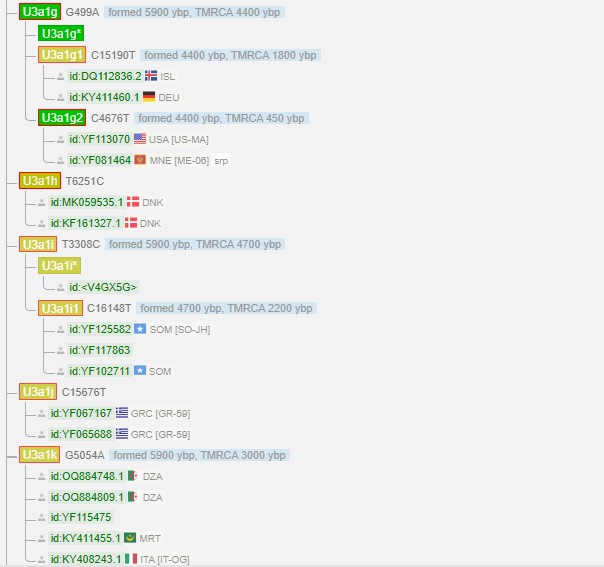Depending on the test or study you look at, the frequency of U3a1 in Somalis is anywhere from 1.5 to 3%. In any case that translates into a segment of the population well into the hundreds of thousands that have U3a1 as their direct female ancestor. Now what's particularly interesting about this 5900 year old subclade is that it has a predominantly European distribution. U3a-a, the ancestor of u3a1, centers in Anatolia (as shown by the nearly 10,000 year old sample), as you'd expect from an Early European Farmer/Anatolian Farmer lineage.
13 out of the 19 subclades are exclusively European
1 out of the 19 subclades is Levantine (U3a1p): One Lebanese, the other a Syrian
3 out of the 19 subclades are empty (Don't know whats up with that, maybe the samples in the paragroup will move into them after the next update?)
Only 2 out of the 19 subclades are African:
1) One centered around NW Africa (U3a1k) containing: 2 unpublished Algerians, 1 Moroccan who took a commercial test (if you search his id he falls under E-M81 and has the flag), 1 'mixed' Mauritanian, and 1 Sardinian
2) The other in Somalia and a mystery sample you can't search up
In regards to the Maghrebi subclade U3a1k. We know both the Cardial culture (during the Neolithic) and steppe carrying Bell Beaker (during the Euro Bronze age) contributed Anatolian farmer ancestry both in terms of autosomal and uniparentals. Pretty straightforward.
The real bizarre case that sticks out like a sore thumb is the Somali subclade U3a1i. Initially when the U3a1 portion of the tree update months ago, I assumed the mystery sample was a Somali, thus assumed this lineage must've hung around Anatolia while the rest of its sisters travelled into Europe. And at a later date travelled down through Anatolia -> Levant -> NE Africa, possibly with the ancestors of the T-L208 Somalis. So in this frame work it would've been present in the early Cushite genepool for >4700 years and 5900 years ago it would've been in Anatolia. But that's wrong...
I inquired about the mystery sample. Turns out its a Turk from Anatolia lol.
The implications of the this new information means the exclusive Somali subclade, which is actually U3a1i1 (instead of just U3a1i) is much younger than I previously believed at only 2200 years old instead of 4700 years old.
She entered into the Somali gene pool anywhere from 2200 ybp to 4700 years ybp instead of entering the Somali gene pool >4700 ybp to <5900 ybp.

That raises the question... Who was this woman? What's the chance she was a Greco-Roman citizen from Europe?
You don't have permission to view the spoiler content.
Log in or register now.
13 out of the 19 subclades are exclusively European
1 out of the 19 subclades is Levantine (U3a1p): One Lebanese, the other a Syrian
3 out of the 19 subclades are empty (Don't know whats up with that, maybe the samples in the paragroup will move into them after the next update?)
Only 2 out of the 19 subclades are African:
1) One centered around NW Africa (U3a1k) containing: 2 unpublished Algerians, 1 Moroccan who took a commercial test (if you search his id he falls under E-M81 and has the flag), 1 'mixed' Mauritanian, and 1 Sardinian
2) The other in Somalia and a mystery sample you can't search up
In regards to the Maghrebi subclade U3a1k. We know both the Cardial culture (during the Neolithic) and steppe carrying Bell Beaker (during the Euro Bronze age) contributed Anatolian farmer ancestry both in terms of autosomal and uniparentals. Pretty straightforward.
The real bizarre case that sticks out like a sore thumb is the Somali subclade U3a1i. Initially when the U3a1 portion of the tree update months ago, I assumed the mystery sample was a Somali, thus assumed this lineage must've hung around Anatolia while the rest of its sisters travelled into Europe. And at a later date travelled down through Anatolia -> Levant -> NE Africa, possibly with the ancestors of the T-L208 Somalis. So in this frame work it would've been present in the early Cushite genepool for >4700 years and 5900 years ago it would've been in Anatolia. But that's wrong...
I inquired about the mystery sample. Turns out its a Turk from Anatolia lol.
You don't have permission to view the spoiler content.
Log in or register now.
The implications of the this new information means the exclusive Somali subclade, which is actually U3a1i1 (instead of just U3a1i) is much younger than I previously believed at only 2200 years old instead of 4700 years old.
She entered into the Somali gene pool anywhere from 2200 ybp to 4700 years ybp instead of entering the Somali gene pool >4700 ybp to <5900 ybp.

That raises the question... Who was this woman? What's the chance she was a Greco-Roman citizen from Europe?
You don't have permission to view the spoiler content.
Log in or register now.
You don't have permission to view the spoiler content.
Log in or register now.
Last edited:
